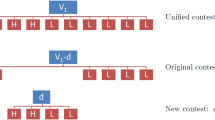Abstract
Contested Pile methods are two-phase procedures for the fair allocation of indivisible items to two players. In the Generation Phase, items over which the players’ preferences differ widely enough are allocated. “Contested” items are placed in the Contested Pile, which is then allocated in the Splitting Phase. Each phase can be carried out using several different techniques; we perform a comprehensive analysis of the resulting design variants using a computational model. The properties of fairness and efficiency, generally achieved in the Generation Phase, must be traded off against robustness to manipulation. We find that the recently developed Undercut procedure for the Splitting Phase outperforms alternative methods in both fairness and efficiency. In general, procedures that keep the Contested Pile relatively small and incorporate the Undercut procedure score well in both fairness and efficiency, but are prone to manipulation.











Similar content being viewed by others
Notes
A strict preference on \(C\) is a relation that is asymmetric, transitive, and weakly complete, and necessarily irreflexive. All items are desirable, so the most preferred subset is \(C\) and the least preferred is \(\emptyset \). Adding an item not in a subset, or replacing an item by a more preferred one, produces a more preferred subset. See Barberà et al. (2004) for details on preferences over subsets.
For more information on this ordering and a brief historical note, see Taylor and Zwicker (1999, p. 93).
References
Asadpour, A., & Saberi, A. (2007). An approximation algorithm for max–min fair allocation of indivisible goods. In STOC’07 Symposium on Theory of Computing, ACM, pp 114–121.
Bansal, N., & Sviridenko, M. (2006). The Santa Claus problem. In J. Kleinberg (Ed.) STOC’06 Symposium on Theory of Computing, ACM, pp 31–40.
Barberà, S., Bossert, W., & Pattanaik, P. K. (2004). Ranking sets of objects. In S. Barberà, P. J. Hammond, & C. Seidl (Eds.), Handbook of utility theory (Vol. 2, pp. 893–977). Dordrecht: Kluwer.
Beersma, B., & De Dreu, C. (2002). Integrative and distributive negotiation in small groups: Effects of task structure, decision rule, and social motive. Organizational Behavior and Human Decision Processes, 87(2), 227–252.
Bezáková, I., & Dani, V. (2005). Nobody left behind: Fair allocation of indivisible goods. ACM SIGecom Exchanges, 5(3), 11–18.
Bouveret, S., & Lang, J. (2011). A general elicitation-free protocol for allocating indivisible goods. In T. Walsh (Ed.), Proceedings of the Twenty-Second International Joint Conference on Artificial Intelligence (Vol. 1, pp. 73–78). Barcelona: AAAI Press.
Bouveret, S., Lemaître, M., Fargier, H., & Lang, J. (2005). Allocation of indivisible goods: A general model and some complexity results. In Proceedings of the Fourth International Joint Conference on Autonomous Agents and Multiagent Systems. New York: ACM.
Brams, S. J. (2006). Fair division. In B. R. Weingast & D. Wittman (Eds.), Oxford handbook of political economy (pp. 425–437). Oxford: Oxford University Press.
Brams, S. J., & Taylor, A. D. (1996). Fair division: From cake-cutting to dispute resolution. New York: Cambridge University Press.
Brams, S. J., Kilgour, D. M., & Klamler, C. (2012). The undercut procedure: An algorithm for the envy-free division of indivisible items. Social Choice and Welfare, 39, 615–631.
Chevaleyre, Y., Dunne, P. E., Endriss, U., Lang, J., Lemaître, M., Maudet, N., et al. (2006). Issues in multiagent resource allocation. Informatica, 30, 3–31.
Dall’Aglio, M., & Mosca, R. (2007). How to allocate hard candies fairly. Mathematical Social Sciences, 54, 218–237.
Klamler, C. (2010). Fair division. In D. M. Kilgour & C. Eden (Eds.), Handbook of group decision and negotiation (pp. 183–202). Dordrecht: Springer.
Lubell, D. (1966). A short proof of Sperner’s lemma. Journal of Combinatorial Theory, 1, 299.
Matt, P. A., & Toni, F. (2006). Egalitarian allocations of indivisible resources: Theory and computation. In M. Klusch, M. Rovatsos, & T. R. Payne (Eds.), Cooperative information agents X (pp. 243–257). Berlin: Springer.
Mykyta, E. F., & Cheng, C. Y. (1994). Generating correlated random variates based on an analogy between correlation and force. In J. D. Tew, S. Manivannan, D. A. Sadowski, & A. F. Seila (Eds.), Proceedings 1994 Winter Simulation Conference, pp 1413–1416.
Nace, D., Doan, L. N., Klopfenstein, O., & Bashllari, A. (2008). Maxmin fairness in multi-commodity flows. Computers and Operations Research, 35, 557–573.
Sebenius, J. K. (1992). Negotiation analysis: A characterization and review. Management Science, 38(1), 18–38.
Taylor, A. D., & Zwicker, W. S. (1999). Simple games. Princeton: Princeton University Press.
Thompson, L. (1991). Information exchange in negotiation. Journal of Experimental Social Psychology, 27, 161–179.
Tripp, T. M., & Sondak, H. (1992). An evaluation of dependent variables in experimental negotiation studies: Impasse rates and Pareto efficiency. Organizational Behavior and Human Decision Processes, 51, 273–295.
Vetschera, R. (2010). A general branch-and-bound algorithm for fair division problems. Computers and Operations Research, 37, 2121–2130.
Vetschera, R., & Kilgour, D. M. (2013). Strategic behavior in contested-pile methods for fair division of indivisible items. Group Decision and Negotiation, 22, 299–319.
Zukerman, M., Mammadov, M., Tan, L., Ouveysi, I., & Andrew, L. L. (2008). To be fair or efficient or a bit of both. Computers and Operations Research, 35, 3787–3806.
Author information
Authors and Affiliations
Corresponding author
Rights and permissions
About this article
Cite this article
Vetschera, R., Kilgour, D.M. Fair division of indivisible items between two players: design parameters for Contested Pile methods. Theory Decis 76, 547–572 (2014). https://doi.org/10.1007/s11238-013-9385-0
Published:
Issue Date:
DOI: https://doi.org/10.1007/s11238-013-9385-0




